I am not a good dancer. That doesn’t stop me from tearing it up in the kitchen to my 80s music mix. I used to dance a lot more, and in public; despite my introvert persona, I rarely missed a school dance as a teenager. Music has always moved me, literally.
During college years ago, a friend gave me a mix tape of EDM (electronic dance music), the dance club music du jour of the early 1990s. The throbbing beats, the frenetic yet organized energy, and the layers of sound revealed spaces in me that were simultaneously dark and light. It was an altogether different experience from anything heard on mainstream radio. This music vibrated inside of me. This, friends, was my introduction to deep house and techno music.
Detour
My hometown and the small city where I went to college are not complete backwaters, but my opportunities to rave were limited. This was a time way before the internet connected everything to everyone, including disclosing where one might find a makeshift underground club pulsating magic from the turntables — if you weren’t already somehow plugged into that scene, you would likely miss out.
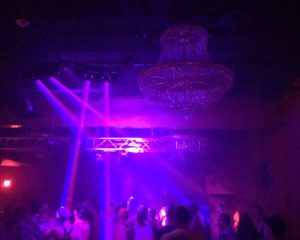
Once out of college, I dipped into the bar/dance clubs only a handful of times, those glorious beats pounding on me, before the circumstances of life took me elsewhere.
It’s not that anyone held me back from dancing; I admittedly just didn’t seek it out on my own. Life proceeded.
Revival
Almost 20 years later, I make a new friend who would open a portal back to that place.
During our first year of finding out all the ways we are alike, she offhandedly mentions a couple of local DJ collectives that curate house music dance parties, bringing in guest DJs from around the country to join local DJs for all night shows. She has fond, magical memories of her youngest brother’s time as a DJ. She says that the upcoming gathering to celebrate Rochester Pride* is only a few weeks away.
*When she came out, on the dance floor at gay clubs was the first place she felt completely at home.
She asks:
Do you want to come dancing?
I haven’t been out dancing in almost 25 years. I am in my mid-forties; I go to bed at 9:30 and suffer from tinnitus in my left ear, recurring tendonitis in my right foot, and knees that may be starting a downward spiral.
Without hesitation, I answer:
Yes. Yes I do.
Now, how to execute a night of dancing as <ahem> a seasoned adult? These dance parties are scheduled to run 10PM to 4AM. My recent experiences of wakefulness between those hours are ones of being in the throes of either a hot flash or a horrible cold. On this hot July night, I’m getting ready for the dance floor.
What is about to follow is a religious experience.
Pre-Game and Glam
The past few years have held for me a number of life-changing experiences followed by a period of getting reacquainted with myself. After a bout of a serious illness, my body is different and so is my mind; one may be weaker while the other is stronger. Which is which tends to change with the day. The very energy that makes up my soul may even be different. My sense of the Universe and how it weaves through everything and everyone is heightened.
Going Dancing is really a two-day affair, inclusive of preparation, the dance party, and recovery. Whenever I describe this ritual to any of my generational peers, I see expressions ranging from deep admiration to horror. It goes something like this:
Day-of, a Saturday….
-
- 11AM: Meet up for the gathering of provisions, which are a dozen macarons from Sweet Sammie Jane’s, and fresh cold-pressed juices from Wegmans.
-
- 1PM: Return home for Disco Nap, preferably between 1pm and 6pm, for as long as possible during that time frame. This means in the bed, under covers, door closed, and ear plugs, as necessary!
-
- By 6PM: Awaken from Disco Nap, shower, prepare and eat dinner.
-
- 8PM: Brew high-quality coffee for pre-gaming.
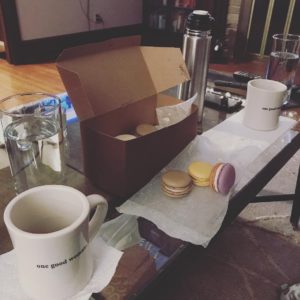
Coffee + Macarons = Fuel for a night on the dance floor.
- 8PM: Brew high-quality coffee for pre-gaming.
-
- 8:30ishPM: Commence Pre-game, which is an important part of dance night! Since both my friend and I exclude caffeine from our daily routines, a cup of regular coffee is pretty much like cocaine for us. To prevent a nauseating high and untimely crash, we have developed the Patented Slow Coffee Ingestion Method™. Said coffee is poured into two insulated thermoses for dispensing in small volumes over the course of a couple hours. We sip, nibble macarons, and basically solve all the problems of the world in a loud, frenetic show of two righteous liberal/feminist women of a certain age, who generally give zero f*cks and are now flying high on coffee and sugar.
- 10:30ishPM: Finish hair, makeup, and costume. Since this club is going to be hot as a sauna regardless of season, we dress for as little coverage as possible, while maintaining our dignity. Ideally a lightweight, sleeveless top with plenty of ventilation (read as: strategic rips and tears, or of a filmy/see-through material you would never wear in daytime) and jeans of generous stretch potential. Sometimes a second top is brought along in case a complete soaking by perspiration requires a wardrobe change. Hair is styled for a night of badassery (Reuzel clay pomade is the current champion). Makeup…well, that’s not my thing, but my friend takes pride in her devastating eyeliner game.
Caffeinated, sugar-charged, and glammed up, we arrive fashionably late like a couple of obverse Cinderellas ready to take on the ball at the stroke of midnight. (Princes need not apply.)
Do You Know House?
House/Dance Music — like many of the richest art forms of our modern society, music in particular — has roots in cultures historically marginalized by the white-christian-cis-male-dominated mainstream: Those of African American, Latinx, and LGBTQ+ people. We owe these groups a mountain of gratitude, if not worship, for sharing their art, their absolutely critical push-back on society, and insisting upon the safe spaces that brought forth this revolution in musical culture. (Read more about black pioneers of house music here and about the roots of dance in gay culture here.)
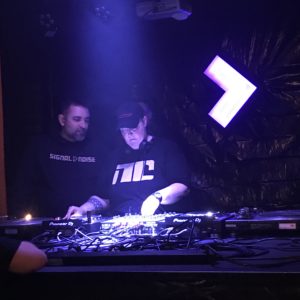
The underground clubs of Chicago and Detroit served as the crucible, the places where these artists and pioneers, DJs of House and Techno music, many POC and many LGBTQ+, could explore their visions of sound layers and relentless beats in defiant answer to a world that would not hear of it. Those same venues became havens for people who could not safely move through mainstream clubs as their authentic selves.
On the dance floor, among the sweat and the bodies and the thundering beats, everyone was exactly where they belonged.
5 By 5
Inclusivity still rules the House dance floor today. In fact, local show curators and hosts Sole Rehab and Signal > Noise prioritize it. My experience is not unique: the welcome mat is out for anyone who wants to be moved by the music. Actually, it’s more than that — arms are wide open to anyone who wants needs to be embraced by House and its denizens.
It’s an all-encompassing energy flow of love, acceptance, and peace. It is raw and it is refined. It is getting drenched in the sweat of an acquaintance who bear-hugs and kisses you hello before disappearing back into the crowd. It is the giddy smiles of young strangers gravitating towards your glow-stick bracelets, which you slide off your arm and onto theirs. It is the bubble of safe space my friend and I, both of us petite, project around our corner of the dance floor.
It is the eye contact and skin contact and aural solidarity of people dancing and loving and being as their authentic selves.
Lose Yourself
That first night, celebrating Rochester Pride 2017, is a revelation. My last visit to the dance floor is a dim, distant memory. And, honestly, now I can feel and inhabit the experience in a way that I couldn’t have all those years ago. I am a little less than a year past the epiphany that I survived cancer; I have felt mySelf supernova, and that delicious, invincible, euphoric “That’s right motherf*cker”-high has begun to ebb.
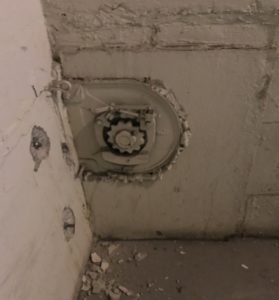
On a steamy July night, we walk into a wall of sound and heat. Bodies move en masse. The darkness is cut through with laser lights that reflect on the vapor-heavy air, these sweating bodies producing a better light show medium than any smoke machine could.
It is our instinct, both of us, to stand at the edge of the dance floor, letting it all wash over us while waiting for one particular beat, one dramatic drop, to hook us in. It is as if our core energy needs to recalibrate, letting go of external excesses before assimilating again to the dance floor. Not to lose individuality, but quite the opposite — to shed the unnecessary parts of persona and consciousness to get lost in the music… to become fully the Self that is simply moved by the beat.
4/4
We step out and begin. Bodies move all around us, arms embracing, outfits slaying, folding fans snapping open in time with a stunningly dropped beat … all in service to the waves of building and breaking musical tension. When DJ Minx mixes Madonna’s Vogue into her blistering set, this already-jubilant Pride crowd boils over, and I just about vaporize on the spot.
Before our first night at a (legal) warehouse get-down, it takes a day of tracking down the secret ‘to-maintain-inclusive-safety’ location. Once there, we make our way around the back of a gritty set of industrial buildings, one dark edge of the parking lot bordering the river. It is one of the safest spaces in the city that night.
We are usually among the elders of the crowd, and we get our due respect. The young faces we begin to recognize over time begin to recognize us. Are we an oddity? A spectacle? We care not, like old ladies wearing purple. Our dame-energy precedes us, and we leave a wake; this corner of the dance floor is OURS.
The heat and the punishment on our knees crests every hour or so, and one of us leans in to temporarily break the spell for a brief rest. If the doors permit it, we head outside for welcoming fresh air (sometimes frigid air — equally welcomed) and a visit to the cooler in the car to sip the fresh-squeezed juice procured for the sugar nourishment. (We absolutely do not drink alcohol. We’ve expended considerable effort ensuring we can make it to 4AM!)
Sometimes when we head out for these breaks, we are gently accosted,
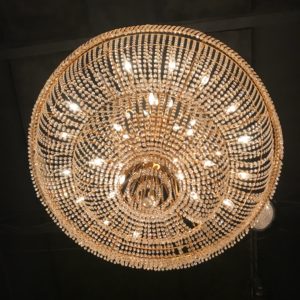
“Are you leaving??”
No, darlings, of course not. We are going to cool off with some juice.
“Juice. Reeeallly?”
Yes, juice, because it is refreshing.
“Oh, right. ‘Juice.’” <wink>
It is juice.
“Oh yeah? I want some ‘juice.’” <follows along>
<Shrug> Ok. <opens car hatch, opens cooler, opens bottles of juice.>
“Huh. It really is juice.”
Yep, we told you. (It’s really not coke.)
Then it’s back to the sound and fury and lights and heat and beats.
Signal > Noise
Am I a good dancer after all? I don’t care. I couldn’t tell you about or show you my moves. For better or for worse, I move by instinct. After a while, I am engulfed by the heartbeat of the music; here is where the constant flow of consciousness stops. In this sweet spot there is no thought. It’s all music and movement — a kinetic meditative state.
Dancing has certainly been proven to be good for you in terms of brain and body health. I mean, for people striving for ‘10,000 Steps Per Day,’ achieving 20,000 steps/10 miles on the dance floor within four hours is great cardio by any metric. Dancing is also good for overall well being; we can dance our way to reduced stress, depression, and anxiety.
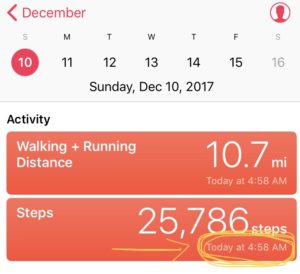
Why? Music and dancing are known to induce the release of endorphins, our very own self-manufactured pleasure-drug. But there is something more to it.
The communal experience. Aside from the subjective cosmic-spiritual reasons, there is neuro- and psychological evidence that dancing in a group alters our brains; there is the social bonding and something that transcends it altogether. This something is called ‘self-other merging.’
To paraphrase: ‘…Neurohormones, dopamine- and oxytocin-release; …spontaneous and unintentional synchrony of movement; …the importance of rhythm in providing a scaffolding to facilitating synchrony with both the music, and by extension, aids synchrony between individuals engaging in the same musical experience; correlation to increased opioid levels associated with social grooming and affiliative behaviors….’ This is science-y stuff, folks. Read about it from the experts.
In a nutshell, when we dance together, we become as one.
Euphoria
That first night, I am all spirit transcending. Euphoria sustains hour after hour, simultaneously exhilarating and exhausting. For Pride weekend, the very air in the club is a rainbow; a celebration, a release of joy, unspoken solidarity. Being on the dance floor reminds me how much I love/missed dancing. We leave it behind well after 3AM, drenched in sweat (have I mentioned the sweat?), and ride home in satisfied, satiated silence, pondering the deserted, pre-dawn city streets.
After a shower and long sleep to late morning, I feel again exactly like I felt the previous autumn after a tough mountain hike. We’ve been dancing every couple of months since, whenever we can make it to one of the curated Sole Rehab or Signal>Noise get-downs.
The next day euphoric-surge-of-life-force is always the same: I wake up feeling FULL — of so much love and so much life, like I did something big and important. Everything has more meaning, I feel like “more.” The bond with my best friend/dance partner deepens; on the dance floor, we go to a church like no other, listening to hymns like no other, and swaying with a choir like no other.
And that’s what dancing to House music really is all about. A soul-connection to being alive alongside everyone else on the dance floor, to everyone else who ever needed dance, to the musician who made the music, and to the DJ who is interpreting it in that moment. Most of all, it is a connection to yourSelf, in a beautiful moment of merging with everything and everyone.

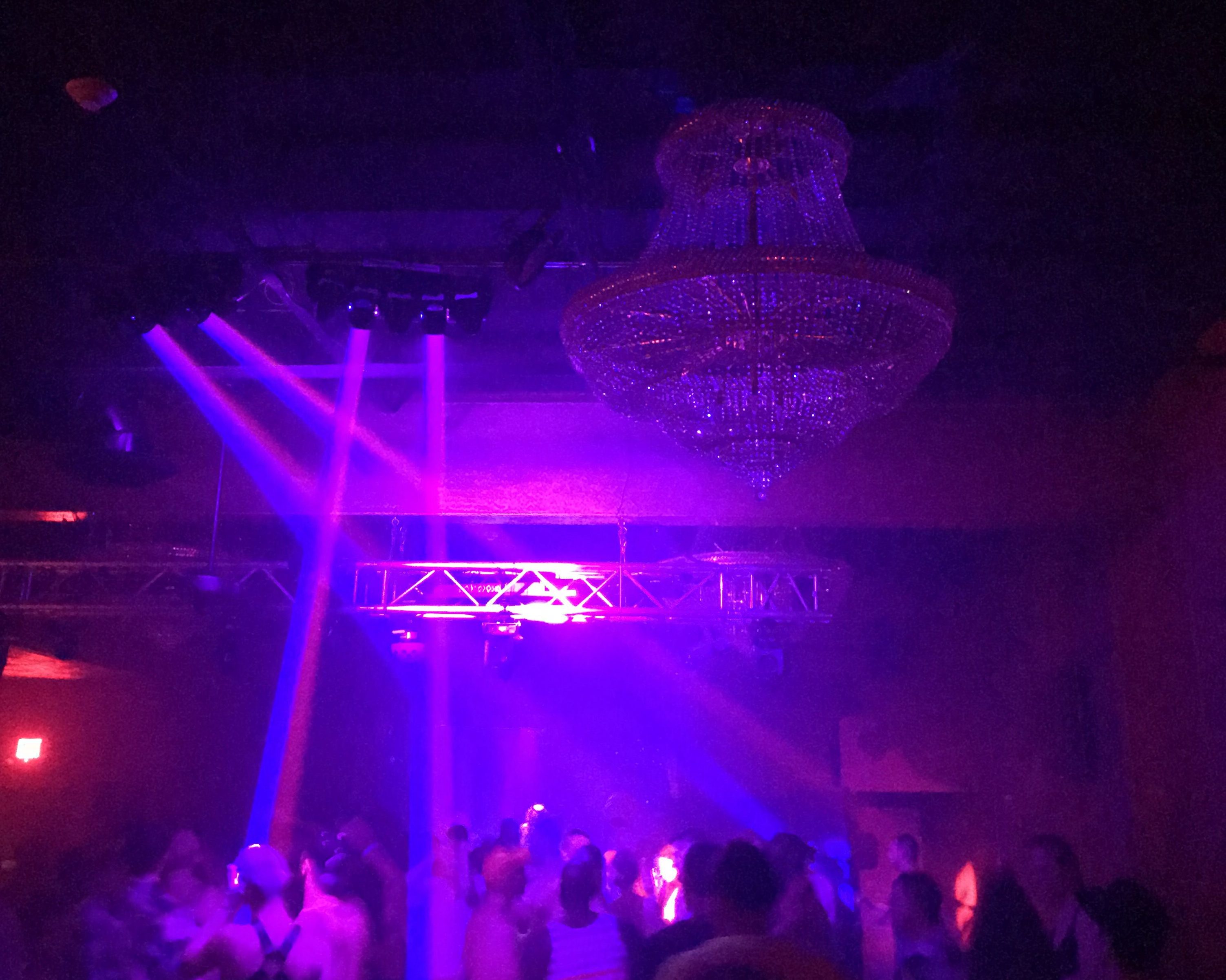
 Swans and Ducklings: A Story of Self-Image
Swans and Ducklings: A Story of Self-Image
